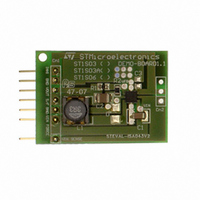STEVAL-ISA043V2 STMicroelectronics, STEVAL-ISA043V2 Datasheet

STEVAL-ISA043V2
Specifications of STEVAL-ISA043V2
STEVAL-ISA043V2
Available stocks
Related parts for STEVAL-ISA043V2
STEVAL-ISA043V2 Summary of contents
Page 1
Introduction The ST1S06 is an adjustable current mode pulse width modulation (PWM) synchronous, step down DC-DC converter with inhibit function optimized for powering all low-voltage applications and, generally, to replace the high current linear solution when the power ...
Page 2
Contents Contents 1 Selecting components for your application . . . . . . . . . . . . . . . . . . . . . . 4 1.1 Input capacitor . . . . . . ...
Page 3
AN2371 List of figures Figure 1. Simplified schematic . . . . . . . . . . . . . . . . . . . . . . . . . . . . . . . . ...
Page 4
Selecting components for your application 1 Selecting components for your application This section provides information to help you select the best-adapted components for your application. Figure 1. Simplified schematic 1.1 Input capacitor The input capacitor must be able to support ...
Page 5
AN2371 The maximum and minimum duty cycles are: Equation 3 Equation 4 Where V is the voltage drop across the internal NMOS and VSW the voltage drop across F the internal PDMOS. Considering the range DMIN to DMAX ...
Page 6
Thermal considerations 2 Thermal considerations The dissipated power of the device is related to three different sources: 1. Switch losses due to the not negligible R Equation 7 Equation 8 Where D is the duty cycle of the application. Note ...
Page 7
AN2371 3 Short-circuit protection In Over-current Protection mode, when the peak current reaches the current limit, the device reduces the t to its minimum value. In these conditions, the duty cycle is strongly reduced ON and, in most of the ...
Page 8
Board usage recommendation 4 Board usage recommendation The board shown in you have two lines available; one used to supply or sink current and the other one used to perform the needed measurement. Figure 2. ST1S06 board picture Figure 3. ...
Page 9
AN2371 4.1 External component selection Figure 5 shows the typical application used to obtain an output voltage of 1.2 V. Figure 5. ST1S06 application schematic Vin In order to obtain the needed output voltage, we must choose the resistor divider ...
Page 10
Board usage recommendation 4.3 Capacitors selection It is possible to use any X5R or X7R ceramic capacitor – 4.7 µF (ceramic) or higher without limit – µF (ceramic) or higher possible to use ...
Page 11
AN2371 5 Bill of materials Table 1. BOM with most often used components Name C1 4.7 µ µF C3 3.3 µH L 4.7 µH 6 Revision history Table 2. Document revision history Date 19-Jun-2006 20-Mar-2008 Value Material Ceramic ...
Page 12
... Information in this document is provided solely in connection with ST products. STMicroelectronics NV and its subsidiaries (“ST”) reserve the right to make changes, corrections, modifications or improvements, to this document, and the products and services described herein at any time, without notice. All ST products are sold pursuant to ST’s terms and conditions of sale. ...




















